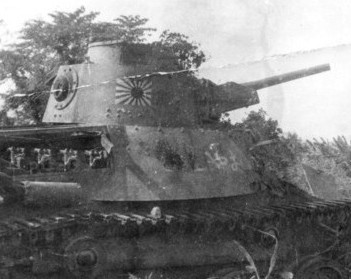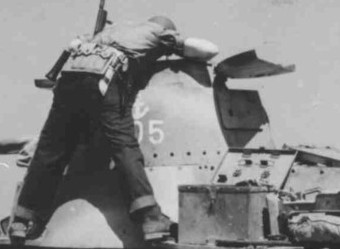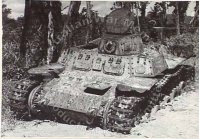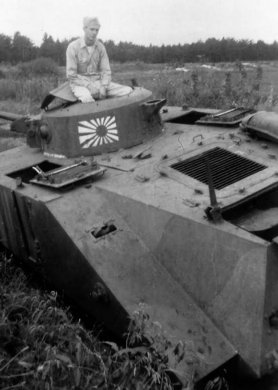
This section introduces some interesting questions and answers among my correspondances to readers.
The question was why didn't the Japanese use/design a coaxial MG in their tanks during WW 2?
In other countries, coaxial MG was used to suppress the enemy by scattering bullets. But, IJA did not agree with it. In IJA doctrine, the gun was to hit the enemy. IJA was poor army and they hated to waste ammunition.
To aim at moving enemy infantry, MG had to be moved quickly. So, the turret MG of Japanese tanks was mounted at independent MG mount. Until Chi-Ha, it was placed at the rear of the turret. Note that the MG of rear turret was not to shoot backwards. When shooting enemy infantry, the gunner changed the tank gun to MG by rotating the turret and shot forwards.
However, the gunner often lost the target while rotating the turret. So, it was required to mount MG at front turret. But, there was no room to place an independent MG mount at the front turret. So, the coaxial MG was adopted for light tanks like Ke-Ni or Ke-To and Ka-Mi. But, their coaxial MG structure was different from that of western tanks. The tank gun mount with MG could be moved horizontally as well as vertically like ball mount and it was moved by the shoulder of gunner. So, it could chase the target quickly. IJA doctrine did not change on it.
Thought it was possible in case of 37mm gun of light tank, it was impossible in case of large caliber gun like 75mm of Chi-To. It was too big to move quickly and too heavy to support by shoulder. So, coaxial MG was given up and MG was again placed at independent MG mount.
IJA doctrine prevented IJA from adopting coaxial MG to the last.
I’m serching information regarding Type 95 Light Tank "Ha-Go" in navy use. I’ve saw one version in grey/blue done by MIG Jimenez but I cannot find any book or magazine information with colors and markings.
The Navy did not repaint Ha-Go obtained from the Army. So, they were in the same colors as IJA. Ha-Go in Navy grey is a nonsense.
Naval ensign or anchor mark were painted on the turret of Navy Ha-Go.


I also picked up a book by Andrzej M. Tomczyk called Japanese Armor vol. 1. In this book he has color drawings of several tanks. One tank, a Type 89 A belonged to the SNLF. Instead of painted in a camo pattern, it is painted a blue/gray. What type of tanks did the SNLF use in the Pacific and how would they by painted ?
He is wrong. SNLF Type 89 was painted in overall Khaki. Note that SNLF Type 89 was used in China. The Navy did not use Type 89 in the Pacific.
Given that Japan had bought the technology for the 20mm oerlikon cannon, and that technological exchange with Germany must have made the IJA aware of the strengths of open-breach, belt-fed machine guns, why did the IJA continue to use strip-fed weapons for infantry fire-support?
The IJA developed a belf-fed machine gun (Type 98 Water-cooled Heavy Machine Gun). But, it was only for the fortress and never used in the field.
The reason to develop this gun is that the fortress MG needs to fire continuously in long time. In other words, the IJA field MG did not need it. The IJA doctrine on machine gun is different from that of the Americans. In the IJA, machine gun aimed at a target and fired only a few shots. It never sprayed bullets like Americans. So, they did not need the belf-fed machine gun.
Type 98 Water-cooled Heavy Machine Gun
Is that why light machine guns were furnished with attachments for telescopic sights?
It was a result that the IJA stuck to the accuracy.
The supply of ammunition was always a large problem for the IJA. To save ammunition, the IJA made much of accurate shooting. The IJA doctrine on the shooting of machine gun also came from this problem.
Was there a Japanese Military equivalent to the German "Jerry" fuel can and it's British and US copy?
No, any fuel cans like Jerrycan did not exist in Japan. Only feul drums were used by the Japanese. Japanese tanks carrying a fuel drum like below photo were often seen in China.
I'm working on Tamiya's Type 97 Chi Ha, but have noticed the periscope detail is missing on the underside of the turret hatch. I've seen some photos of parts of it, but nothing that shows it clearly. Are there any photos or drawings of this device that will enable me to build an accurate part?
There is no good photo of the periscope on the hatch, because most Chi-Ha removed a periscope cupola. On the below photo, a periscope itself was removed, but it will be helpful to know the underside of the periscope cupola.
Do you have any information as to how often the IJA used a spray apparatus to apply the camouflage patterns to tanks?
First, camouflage patterns were painted by brush. It is not certain when the IJA began to use the spray, but tanks in the late WWII were mostly camouflaged by spray.
I read in a polish review that of the CHI-HA medium tank there were command tanks with dummy guns or the 57 mm Type 90 gun and bow mounted 37 mm installed in the glacis too. Is it true?
No. It is a misunderstanding due to the doctored photos during the war.
In a recent Polish book, it states that only Chi Ha command tanks carried the copper radio antennea on the turret, is this true?
It is a mistake. Basically, all Chi-Ha tanks were equipped with an antennea on the turret. A few Chi-Ha tanks in the late WWII had no antennea, but they were exceptions.
On the photos taken by the Americans, wrecked Chi-Ha tanks often had no antennea. But, they lost it in combat and orignially they had been equipped with an antennea.
The Type 89 medium tank was known only as Yi Go by the Japanese, Chi Ro being a name invented in the west. Anyone know of any others?
Wrong names on the Japanese AFV.
Type 94 Medium Tank ---> Type 89 Medium Tank Otsu
Kyu-Go ---> Ha-Go. "Kyu Go" means 95 in Japanese. Somebody would misunderstand it as a nickname.
Type 88 Tankette ---> Type Ka MG Vehicle (Carden Loyd Mk.VI B)
Sumida M.2593 ---> Type 91 Armored Railroad Car
Dowa Armored Car ---> Vickers Crossley Armored Car
Can you tell me, whether the Japanese army and navy used HEAT rounds in their guns (tank-guns, anti-tank-guns, fieldguns and fieldhowitzers), and the performance and data of this rounds.
The Japanese produced following kinds of HEAT shell.
Gun |
Caliber(mm) |
Weight(kg) |
Lenght(mm) |
Penetration(mm) |
Type 90/97 Tank Gun |
57 |
1.80 |
189 |
55 |
Type 92 Infantry Gun |
70 |
3.38 |
281 |
90 |
Type 41 Mountain Gun |
75 |
3.95 |
297 |
100 |
Type 91 10cm Howitzer |
105 |
10.91 |
364 |
120 |
Type 38 12cm Howitzer |
120 |
13.03 |
387 |
140 |
Type 4 15cm Howitzer |
149 |
21.04 |
524 |
150 |
Among them, the HEAT of Type 41 Mountain Gun was used in action and destroyed several Allied tanks in Burma and other places. The use of the HEAT for other guns is not known.
Below is the photo on the HEAT of Type 94 Mountain Gun. The HEAT of Type 94 Mountain Gun was not produced though it was developed.

The ships (Landing Craft carriers) "Shinshu Maru" and "model Ko" and submarine "Maru Yu", did have IJA or IJN officers?
As for the landing craft carriers, crews were civilians and they were hired by the IJA. The crews for the guns and landing crafts were IJA soldiers.
The crews of the "Maru Yu" were IJA soldiers. They were mainly converted from tankers.
Did the average soldier like the dustcover on his rifle? Among collectors, there is much speculation on this as many rifles were captured without the original equipment dustcover.
The late production of Type 99 rifle omitted the dustcover. And the dustcover was often removed in the Pacific front, because it was attached to the rifle for the dusty China continent.
In what manner did the Japanese Military distribute the Type 99 rifle after it replaced the Type 38.
The change of the rifle from Type 38 to Type 99 was carried out division by division, because the ammunitions must be unified in a division. At first, the divisions in Manchuria changed Type 38 to Type 99. Then, the divisions in Japan homeland changed. The divisions in the Pacific front were the last. However, the change of the rifle was not finished during the war. So, many infantrymen in the Pacific used Type 38 until the war ended.
I understand that the Ho-Ni (I) was used as a tank destroyer because the gun could not be elevated high enough to provide indirect fire.
Ho-Ni I is not a tank destroyer, but a SP artillery. The sight of Ho-Ni I is the same as that of Type 90 75mm Field Gun and it was not fit for the direct fire. It is true that the elevation of Ho-Ni I is not enough. So, the range is shorter than that of the original field gun, but it does not mean that the indirect fire is unable. On the Philippines, Ho-Ni I were deployed in the artillery unit and used for indirect fires.
The Ho-Ni (II) was sporting a 105mm gun and some sources reffer to it as SP artyllery while others still call it a tank destroyer. Ho-Ni (III) the only thing I can find here is that the fighting compartment was fully enclosed.
No-Ni II is a SP artillery as well as No-Ni I. No-Ni III was developed in order to improve the anti-tank capability of the tank unit. It had two kinds of sight for direct and indirect fire. However, the sight for direct fire is a simple device only with a muzzel sight and a rear sight like the sight of rifle or pistol. So, it is assumed that its anti-tank capability was not enough.
Type 97 Mini Engineer Vehicle "Yi-Go" was copied from the German Sd.Kfz. 302 "Goliath" ?
The development of Yi-Go started in 1933 and it was introduced in 1937. It was far earlier than Germany developed the Goliath. Later, the designer of Yi-Go knew of Goliath and he thought that anyone will think out the same thing.
These are Australian Army photos taken early in 1945 at Wewak on the north coast of Papua-New Guinea. The vehicle was found abandoned when the 6Div AIF moved through the area. Can you tell me anything about the model or designation of this vehicle?

Australian War Memorial
It is the experimental excavator. The device in the stern is a plow to dig a trench. Below photo was taken when it was tested in Manchuria in 1939.
Question about the Ke-Nu at Kubinka
The most interesting fact on that vehicle is that it is not a standard Ke-Nu. It differs in several parts from the standard Ke-Nu and it does not have an extra nameplate of Ke-Nu. I enclosed a photo of the standard Ke-Nu, so compare it with the Kubinka's vehicle.
|
|
The Kubinka's Ke-Nu may have been converted from a Type 95 Light Tank locally somewhere in Manchuria or Russia. There is no information about the origine of that vehicle, but it was as it is when it arrived at Kubinka. The Ke-Nu at Kubinka is still wrapped in mytery.
Did the Japanese have the capability to airlift their smaller tanks into an airfield? What about other types of vehicles?
IJA had studied on the airborne tank and actually organized an airborne tank unit. It was equipped with Type 98 and Type 2 Light Tanks. In order to airlift these tanks, IJA had developed the gigantic transport glider "Ku-7". It could lift the 7-ton cargo. Only 2 planes were produced, because the production of the heavy bomber to draw Ku-7 was delayed and had been cancelled in the long run.
IJA had an airborne artillery unit as well as the airborn tank unit. It was equipped with mountain guns and light trucks.
These units were planned to drop on Okinawa togather with the Giretsu paratroops, but this plan was cancelled due to the delay of the production of transport planes.
Ku-7 Transport Glider
By the way, amphib tanks were dark grey not camouflaged. Is this true?
At first, they were solid dark grey like the navy vessels. However, the color of the IJN amphibious tanks changed to green in 1943. Ka-Mi Tanks landing on Leyte were painted in solid green.
The camouflage was also applied and some late produced vehicles were painted with waved stripes. The color of the camouflage is not known, but it will be two tones of green. In the late WWII, IJN vessels were camouflaged as below link. So, it would be applied to Ka-Mi.

Example of IJN camouflage on Ka-Mi
I thought the yellow lines were only used for the jungle regions.
It is a misunderstanding which is widely spreading. The camo scheme with the yellow lines is not for jungle. It had been already used during the Sino-Japanese War before the Pacific War.
I did not know they were also used in Manchuria. What few photos I have seen of the Type 95 in Manchuria I could not ditiquish any yellow lines. Am I wrong in this point?
I enclosed the photo of the Type 95 Manchuria model (Special model for Manchuria). This photo was taken in Manchuria and this vehicle belongs to the teaching unit of the Manchuria Tank School.
Is it true that the German made PAK 35/36 was used on Guadalcanal? Do you have any pictures?
Yes, it is true. Many German 37mm AT guns were captured in China and some were used in Guadalcanal. They were called as Type Ra 37mm AT Gun. Besides PAK 35/36, some other models of German 37mm AT guns were also captured in China. They were modified with Japanese parts in order to adapt the Japanese use.
|
Was there any typical sabres for IJA officers (I read that Imperial Japanese Navy officers used them)?
During the early period of IJA, some sabres were introduced. However, they were out of favor with officers and NCOs, because the Japanese traditional swordsmanship was not fit to the sabres. In 1934, the use of sabres was discontinued and only Japanese swords were used.
Some types of military sword were introduced and they were used until the end of WWII. If you are interested in military swords, refer to the following site.
http://www.geocities.com/Pentagon/Quarters/9528/index.htm
IJN also discontinued sabres in 1937 and used Japanese swords.
Did You knew that Japanese rifles saw action in Europe?
The Japanese rifle used worldwide is Type 38 Rifle, known as Arisaka Rifle. Many countries imported Arisaka rifles in large numbers, for example, England, Russia, Finland, Thailand, China etc. In Europe, the Finnish Army introduced Arisaka Rifle and used them in the wars with Soviet Union.
There is an episode to tell how widely the Arisaka Rifles were used. It was Arisaka Rifle that Lawrence of Arabia used in combat with the Turkish.
How widely did IJA use armored cars and what were the most widely used models?
Some imported armored cars like Austin or Wolseley and domestic ones of Chiyoda and Sumida were used in China from 20s to early 30s. However, armored cars did not play an important role in the Japanese forces. Different from Europe, the roads in Asia were very poor and wheeled cars could not activate much enough.
Instead of wheeled armored cars, IJA introduced tracked armored cars. They are Type 92 Combat Car and Type 94 Tankette. In fact, they were called armored car by IJA, though I don't use this classification in my homepage in order to avoid the confusion of readers.
But as for Type 89: there were two or three versions of this tank?.. (In some sources I found Type 89 Otsu called "Type 92", and, moreover, "Type 94", as for the last version...) - In the book there's a picture of Type 89 tank with the front MG on the other side of the vehicle's front - and the photo rather isn't mirror image.
Ko of Type 89 mounted a MG on the right of the hull and Otsu mounted a MG on the left. To observe details of Type 89 Tanks, there are many differences even in the same model. I don't know exactly how many versions did exist in Type 89.
Some overseas books call Otsu as the different type name from Type 89, but they are all wrong. I suppose that they are based on the obscure documents made by Allied during the war.
Can you help me on any other pictures or drawings of xxx (Apply your inquiring vehicle name)?
Many pictures of Japanese tanks are collected by a book of "Imperial Japanese Armored Vehicles" published by Delta. This book can be got from "HobbyLink Japan" on the Web. The URL of HobbyLink Japan is,
http://www.hlj.com/
If you need more pictures, please contact me because I have some other sources.
can you tell me more about the M4 that was captured and used by the Japanese on Iwo Jima?
It was recorded in the formal document of IJA, so I think it was a fact.
In the battle around Hill 362C on March 6th, Second Lieut. Michio Otani destroyed two M4 Sherman tanks by explosive charge. He got into the wrecked Sherman and fought with other Sherman tank(s) and destroyed one Sherman.
It is a really incredible story, but Otani was honored by this distinguished service
Can you tell me what SNLF stands for? Also, can you tell me what Ha-Go, Chi-ha, CHi-ri, and Te-Ke means?
SNLF is the abbreviation of "Special Naval Landing Force". It's like Marine Corps in Japanese Navy.
Ha-Go means "The Third Car" in Japanese. It indicates that Ha-Go was the third tank which the Japanese developed. Yi-Go means "The First Car". The second was Type 95 Heavy Tank.
First portion of the tank name indicates its classification. Chi is the abbreviation of "Chiu", meaning Medium. So, Chi indicates the medium tank.
Second portion of the name is a Japanese alphabet and it shows the order of development. Japanese alphabet is as follows,
I(Yi) Ro Ha Ni Ho He To Chi Ri Nu Ru ....
So, Chi-Ha means "The third developed medium tank". Note that it is the order of development, not introduction. So, as for some tanks, their order is not in accord with that of the introduction. For example, Chi-Nu is the last medium tank on the development order.
Te-Ke seems the abbreviation of something, but I cannot find what was it.
Below, I write the meaning of the names which are identified now.
TK ... Tokusyu-Keninsha (Special Tractor)
SS ... Soko-Sagyosha (Armored Worker)
So-Ki ... Soko Kidosha (Armored Railroad Car)
Ke ... Kei (Light)
Ho ... Ho (Gun)
Ka-Mi ... Kaminishi (Designer's name)
First, concerning the France bought NC tanks: how many were bought by Japan? Were they gun-armed or MG-ermed (as both types existed) ?
Japan bought about 23 NC tanks. They were imported without guns. In Japan, they were armed with tank gun or MG. 10 were armed with tank gun and 13 were armed with MG.